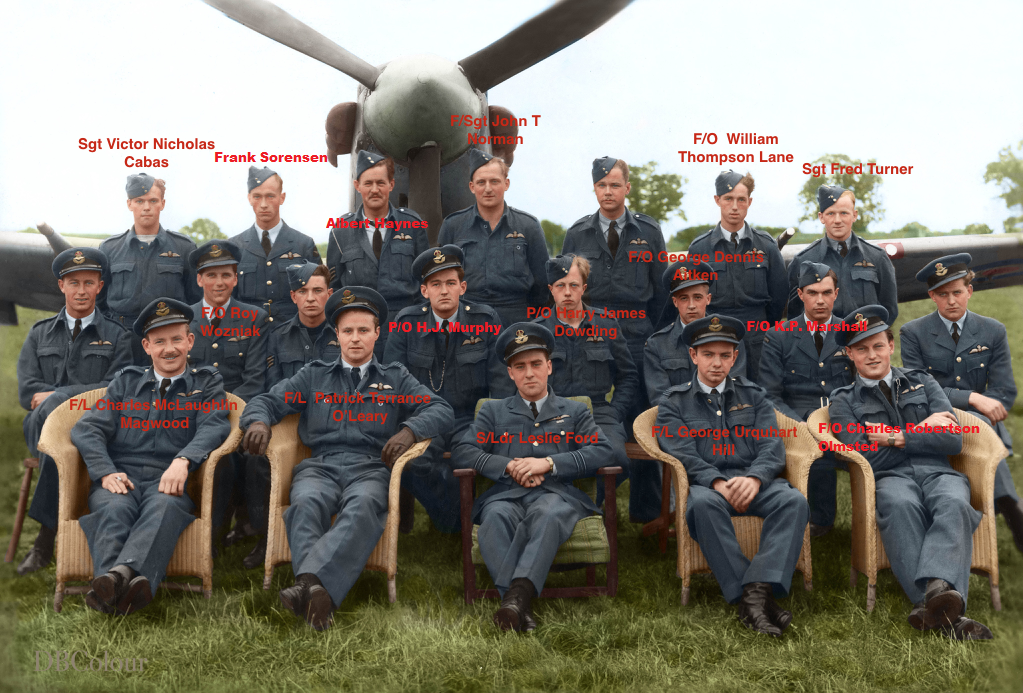Updated
7 april, 2020
Note
Flight Lieutenant Frank Sorensen’s biography was written by his daughter Vicki Sorensen after her father had passed away.
She is sharing what she first wrote. From time to time her father’s biography will change as our research evolves.
My father, Frank Sorensen, immigrated to Canada from Roskilde, Denmark with his family in August 1939. He volunteered in the Royal Canadian Air Force in March 1941 and trained to become a Spitfire fighter pilot. He was shot down while serving with RAF 232 Squadron, over Tunisia, in North Africa on April 11, 1943 and became a prisoner of war at Stalag Luft III. He was an active participant in the tunnel digging operations that was later known as The Great Escape.
After my father’s death February 5th, 2010, when he was 87, I came into possession of letters written by him to his parents during the war that they had saved and given back to him. Along with the letters were numerous photos and service record documents. There were 174 letters in total which start from C.O.T.C., 1940, #1 Manning Depot, #3 Initial Flying Training School, #2 Elementary Flying Training School, #11 Service Flying Training School; all in Canada in 1941 to #17 A.F.U. (Advanced Flying Unit) and #53 O.T.U. (Operational Training Unit) in England in 1942. Then, his service from 1942 in RCAF 403 Squadron, in England, transferring to RAF 232 Squadron in Scotland, then to North Africa. Numerous letters are from 1943 and 1944 from Stalag Luft III, and then a handful from 1945. There were only two short letters from the long march from Sagan to Lubeck – one in March letting his parents know he was still all right, and one in May when they had just been liberated.
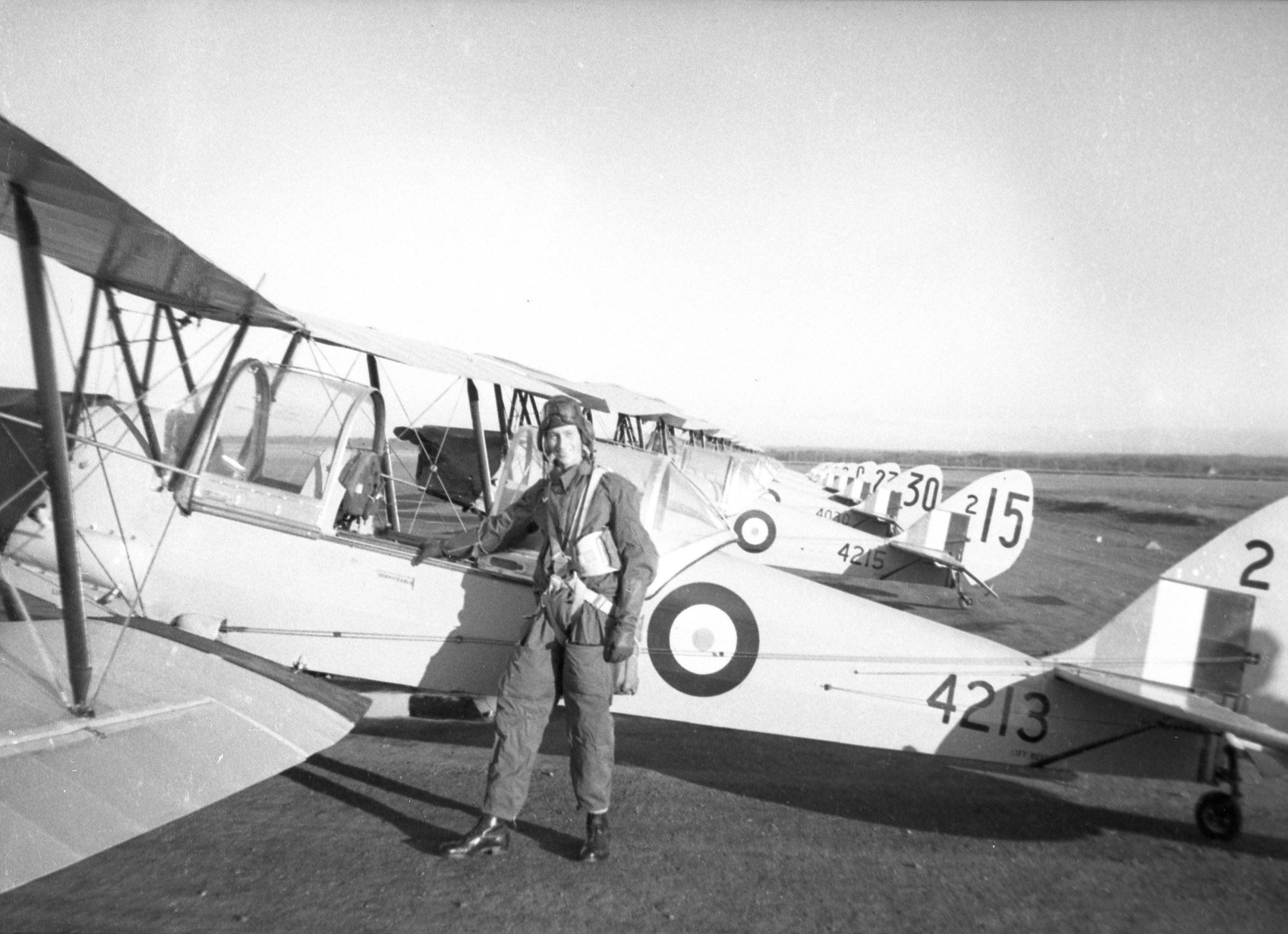 Frank Sorensen, No. 2 EFTS, 1941, Fort William, Ontario
Frank Sorensen, No. 2 EFTS, 1941, Fort William, Ontario
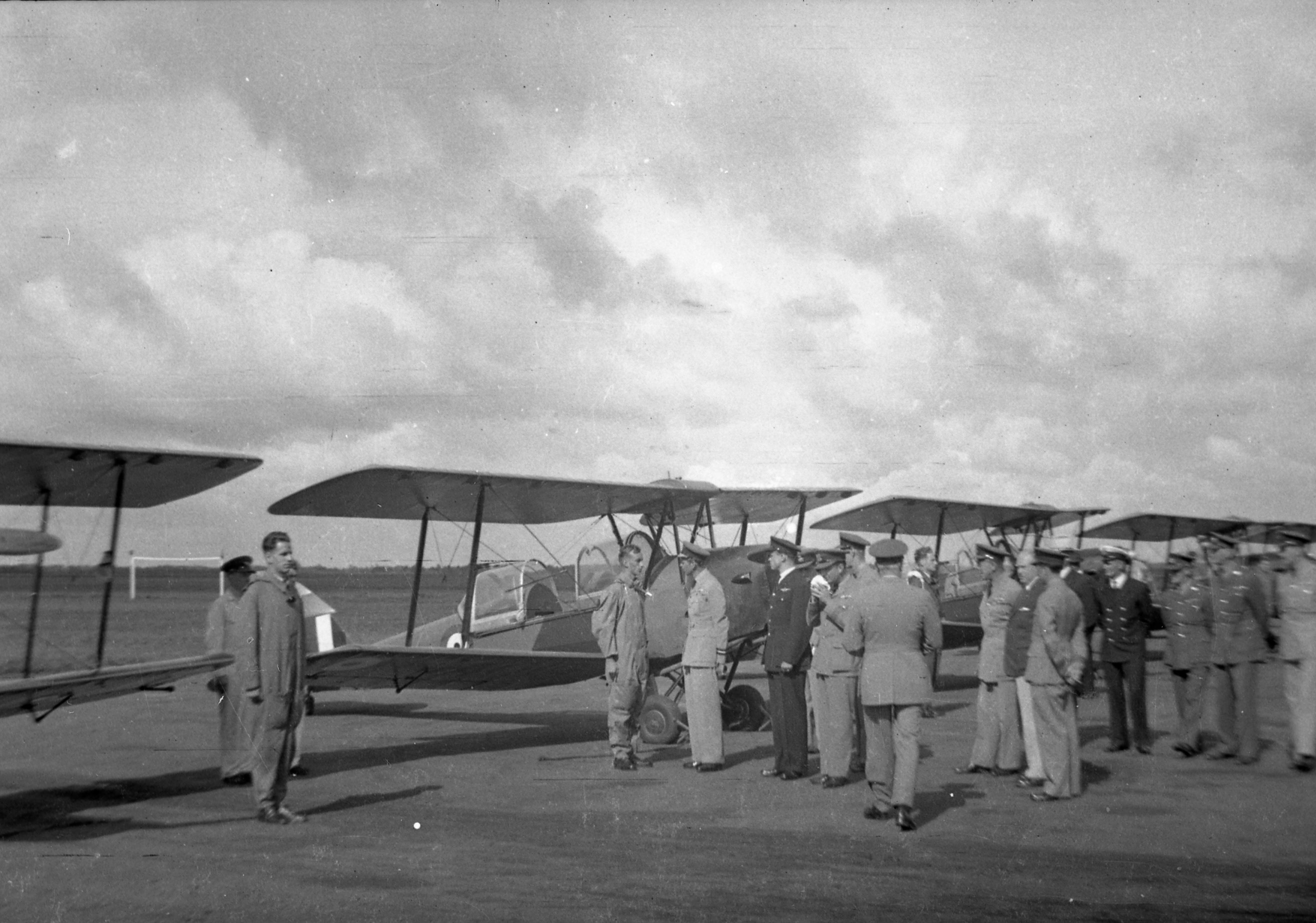
Frank Sorensen speaking to the Duke of Kent, Prince George, Air Commodore, RAF Training Command at No. 2 EFTS, Fort William, Ontario, August 1941
In a letter dated September 3, 1941 my father relayed the following information:
The Duke of Kent visited the station last month and on his inspection of station he spoke to quite a number of us. I am sending an enlargement of the Duke and I “having a friendly chat.” He had a very weak voice; could hardly hear what he said.
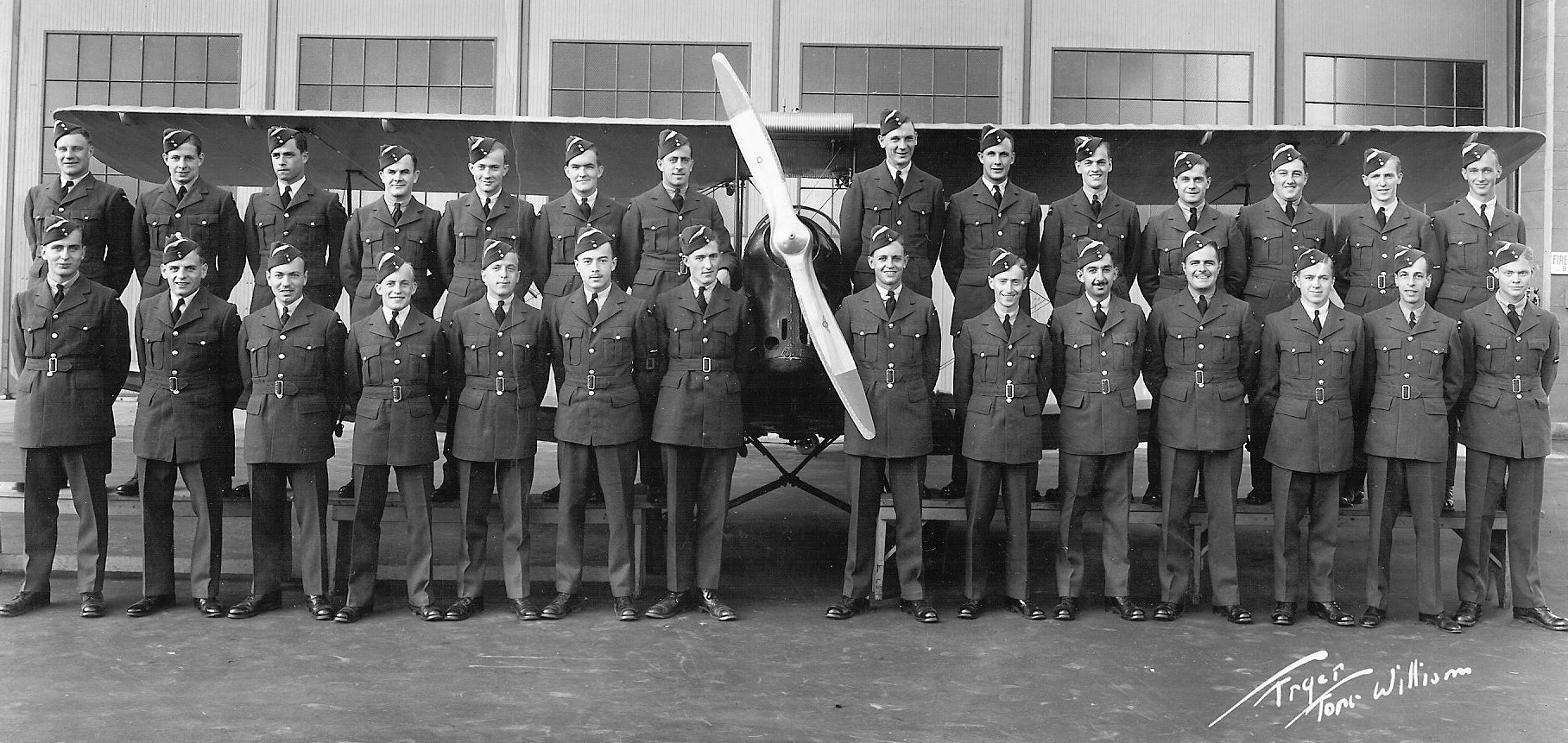
Frank Sorensen (second row, first on right)
No. 2 EFTS, Fort William, Ontario, August 1941
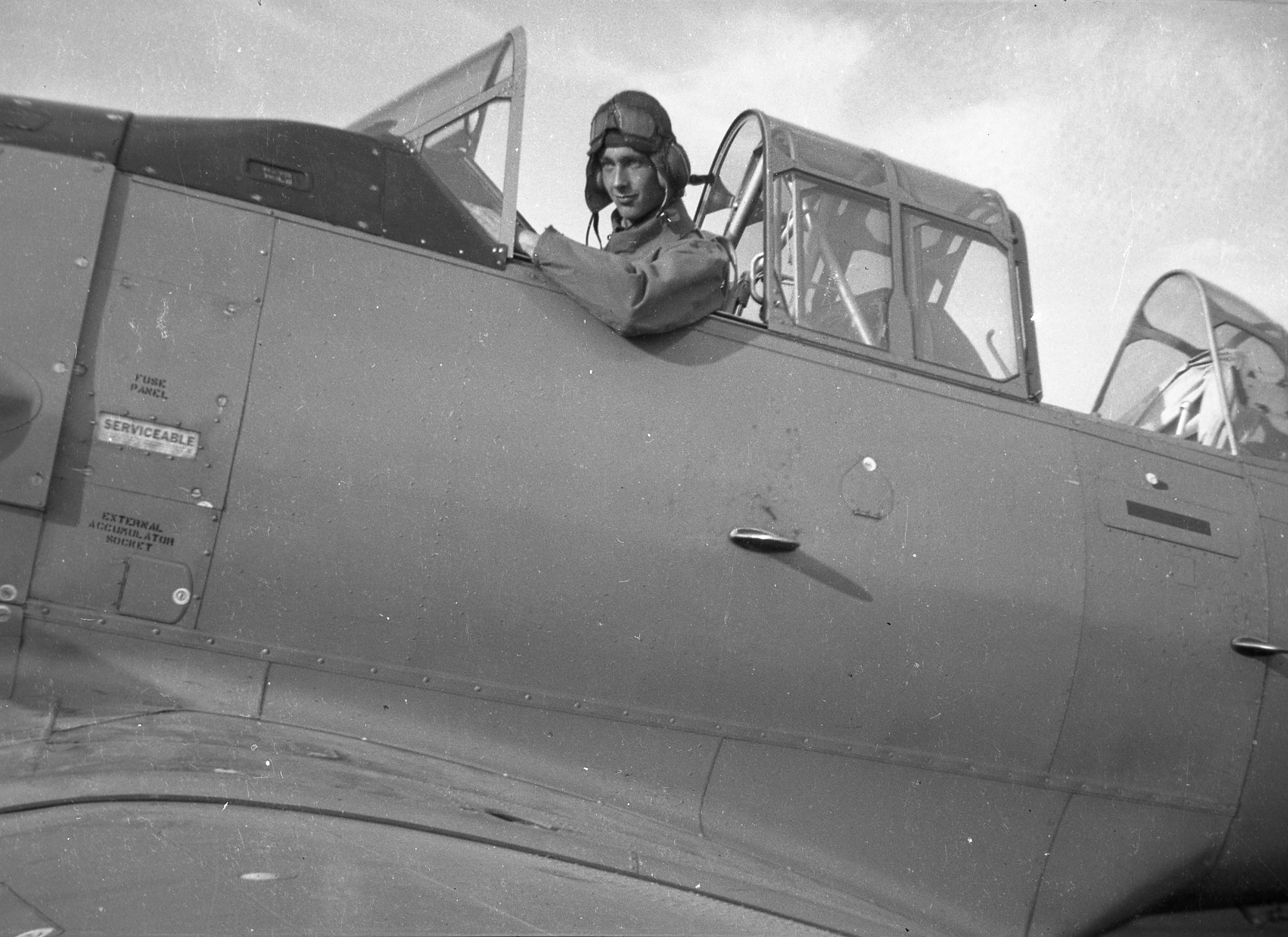
Frank Sorensen in a Harvard trainer, No. 11 SFTS, Yorkton, Saskatchewan, 1941
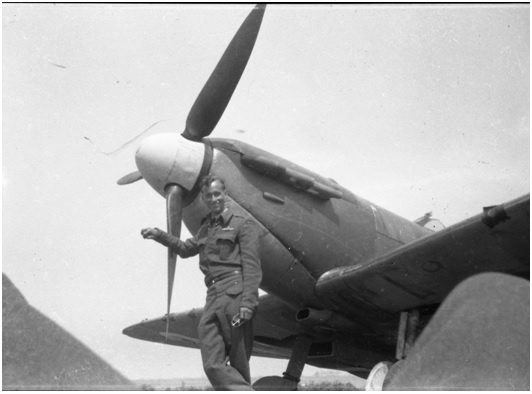
Frank Sorensen with a Spitfire at #53 Operational Training Unit, Wales 1942
My father had hoped to join the Danish air force. He wrote to the Danish recruiting office, but was told that they could not use him because he was a British subject. A picture of this letter dated July 23, 1942 was provided to me by Mikkel Plannthin, webmaster of Danish WW2 Pilots, and author of Britain’s Victory, Denmark’s Freedom. He found the original letter at the National Archives in Copenhagen (http://www.danishww2pilots.dk/).
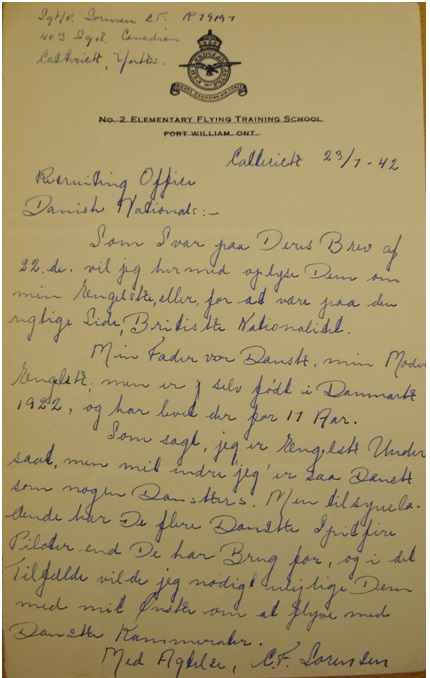
In response to your letter of the 22nd, I hereby inform you of my English, or, to be on the right side, British Nationality.
My father was Danish, my mother English, but I was born in Denmark in 1922 and have lived there for 17 years.
As mentioned, I am British Subject, but in my heart I am as Danish as any Dane. Apparently you have more Danish Spitfire pilots than you need, and in that case I would not bother you with my wish to fly with Danish comrades.
The photo below was not in my father’s effects, but was kindly provided to me in 2012 by Dean Black of the Air Force Association of Canada

Frank Sorensen (back row, second from left),
RCAF 403 Squadron, Catterick, 21 August 1942
The following excerpt is from a letter to his mother dated August 2, 1942 while he was serving in 403 Squadron and on readiness in West Hartlepool, England:
That Danish squad, what there is of it, has no use for me because I am a British subject, though I doubt whether they have enough Danish pilots to complete a squadron. They might change their mind though as I wrote to them and said that after all it isn’t a piece of paper showing one’s nationality that counts, but the way one thinks and feels towards a country. I really don’t feel at home in this Canadian squad. I definitely wouldn’t in an English so I wonder how I would be in this Danish outfit.
It doesn’t mean that I’m unhappy here just that there are none of my type here. I seem to be an “outsider” wherever I go. But I’ve got so used to it now that I really don’t mind. “Mix with the boys” yes and you have to go to their parties such as the one they are having tomorrow. They bought for £15 worth of liqoir (where is my dictionary) and getting a dozen girls up to get drunk with. I refused to come and offered to take somebody’s readiness tomorrow night. Not that I don’t like to go to a party like that, if you thought so, you don’t know me, I like to have a good time as much as anybody, especially with a lot of dead drunk women around. I have just made up my mind not to taste even a harmless glass of beer. I’m preparing myself for the great battle ahead of us, the battle which is going to bring an end to this war; and besides we’ll no doubt be flying faster and more powerful Spitfires by then and there is no place for drunkenness in them.
The following is a speech my father made in Danish over the British Broadcasting Corporation (BBC) radio which aired November 1, 1942, directed to the citizens of Denmark. This had been arranged through his father, Marinus Sorensen who, while living in London, had been selected by the BBC to make broadcasts to the Danish people in their own language. It was his relationship with the BBC that afforded my father the opportunity to speak. According to my grandfather’s letter diaries, a Mrs. Thomsen, who had arranged for my father to speak, “smuggled” the recording out of the BBC and gave it to my grandfather. This speech was on an old vinyl record which could only be played with the thorn from a Hawthorn tree. My father transcribed this onto a cassette tape and followed it with the English translation in 1996, which was the first time I heard it.
Hello hello all in Roskilde – boys from Cathedral Highschool, from the Green Scouts and from the Rowing Club. In other words, all you young Danish men from any part of the country who were boys when I left Denmark with my family for Canada a week before the war broke out. During the summer of ’39, my brother Eric became a graduate from Cathedral Highschool while I was struggling through first year of Cathedral Senior Highschool. Now Eric is Lieutenant with the engineers in the Canadian army and I am a fighter pilot in the Royal Canadian Air Force.
Dad would say, in this war everyone would be part of it and we must make sure we are on the right side of the fence. I was then 17 years old, though I’m an old Roskilde boy, I’m not all that old. I cannot speak with the wisdom and experience of the older folks. So what! See where long bearded, white haired wisdom has landed us. So let also young hearts speak out and let me first of all speak to those who were boys with me, friends from school and Green Scout camps. Who of you would not like to fly with me side by side in the best fighter aircraft the world has known if you had the chance. When I think of you I know that there’s not one who would not consider it his duty and his part of the burden and fight to make Denmark a free country again.
Who among us thought of the freedom which has now been stolen from our country? If we did not understand it in the past we know now what freedom means and you would understand it even better if the Danish window facing the world was clear; but the Germans performed the window cleaning in Denmark and replace a clear view with glossy pictures made in Germany. We may say that our forefathers appreciated freedom but we may also say that they did nothing to protect it from parasites and despicable thugs. Is it possible that we young people have begun to realize what freedom is? Have we begun to understand that it is worth fighting for? Our forefathers gave it to us as a precious legacy, but they gave it us to unprotected. It can only remain ours if we are willing to sacrifice ourselves for it. We must not copy our forefather’s actions. Time has shown that passive resistance when truth and honour are at stake is inappropriate. Our freedom, welfare, are our own responsibility, and we who say that we wish to live in peace must go to war to preserve peace and save our honour.
So we have thought, many thousands of Danes in the free world who are serving in the British and American navy, army and air forces, we think of you as our comrades in arms. There is much you can do. What where and how, you know best yourselves. It is not easy I know. I also know how fortunate I, and my comrades out here are that we are actively engaged in the battle. For us the problem is so simple and straightforward but the latest happenings in Denmark show that it doesn’t pay to wait. For one day you may not be able to choose and then it may be too late. Let us young people fight together now. The day will come when we have won the last battle which will secure Denmark’s freedom and world peace. When the battle is won and the Germans once again are driven out of Denmark let us then celebrate the effort that each one of us has made for Denmark’s freedom.
The photograph below was not in my father’s effects, but was provided to me in 2011 by a WWII veteran, Arthur Sherwin (back row second from right) who had served in RAF 232 Squadron with my father as well as being a prisoner of war at Stalag Luft III. The following information was relayed to me by Mr. Sherwin:
The attached photo was taken in 1943. If you look at the back row from the left side, the second man in, indicated he was from Denmark. He used to entertain us in the evening, by playing a string instrument, which we enjoyed. I got to know him quite well. In the picture, I am in the back row, at the far right. Your father was shot down on April 11, 1943. I was shot down on April 18, 1943. Probably, we arrived at Stalag Luft III around the same time. From then on, until we were released, he must have established relationships that agreed with his. I did the same thing.
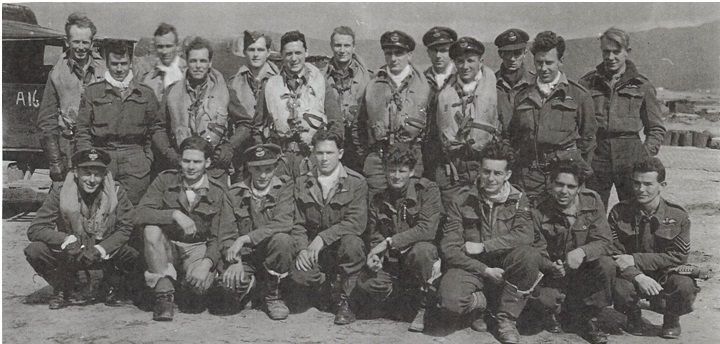
Frank Sorensen (back row, second from left) 232 Squadron,
Tingley, Algeria, February 1943
During my research on the internet, I made the acquaintance of a British man, Pete Cairns who was researching his late grandfather, George Cairns’ wartime service. His grandfather served as ground crew for 232 Squadron and would have known my father. Through his research he was able to identify all of the pilots in the picture above and as well discovered Peter Holmes (front row, fourth from left), still alive living in Middlesex, UK. Through his contact with Mr. Holmes’ son and daughter-in-law, a Skype conversation was arranged between Mr. Holmes and me in September 2013. He relayed the following information about my father:
Your Dad was quite a character – we all enjoyed his sense of humour. Because he was fluent in German we used to egg him on, so he would swear at the enemy in German on the radio transmitter while we were in flight.
The following information was relayed to me by Mikkel Plannthin. The British aviation historian Christopher Shores (and his co-authors) suggest in their book Fighters over Tunisia (1975) that my father was shot down by the German pilot Hauptmann Tonne of I Gruppe, Jagdgeschwader 53:
Meanwhile at 0900 Wg.Cdr. Berry led 12 Spitfires from 81 Squadron, 11 from 154 and 11 from 232 on a sweep over Tunis Bay at 23,000 feet. Over El Aonina JU 52s were seen taking off and 232 Squadron dived to the attack; Bf 109s appeared overhead and ‘nibbled’ at the squadrons during the dive and the way home. Fl.Lt. Lynes set one JU 52 partly on fire when PO Sorensen nipped in and finished it off; but was himself jumped by a Bf 109 and shot down. […] It seems likely that Sorensen and Keller were shot down by Hpt. Tonne* of I/JG53, who claimed two Spitfires on this date.
Wolfgang Tonne* was an accomplished pilot with the Luftwaffe.
Update 7 April, 2020
More recent research conducted by Pierre Lagacé, a retired teacher and amateur historian, has revealed a more likely scenario where my father was shot down by Obfw Heinrich Hackler of 8./JG 77.
Flight Lieutenant Glen Lynes (middle row, second from left) was shot down and taken to Stalag Luft III. Sergeant Ronald Keller (back row, first on right) did not survive. My father was shot down 40 miles west of Tunis. He suffered shrapnel wounds to parts of his body and his legs. He crashed in enemy territory, upside down – hanging in his straps. He remembers the German soldiers watching him and betting if he would get out of the aircraft before it blew up. He got himself out of his gear and was taken prisoner.

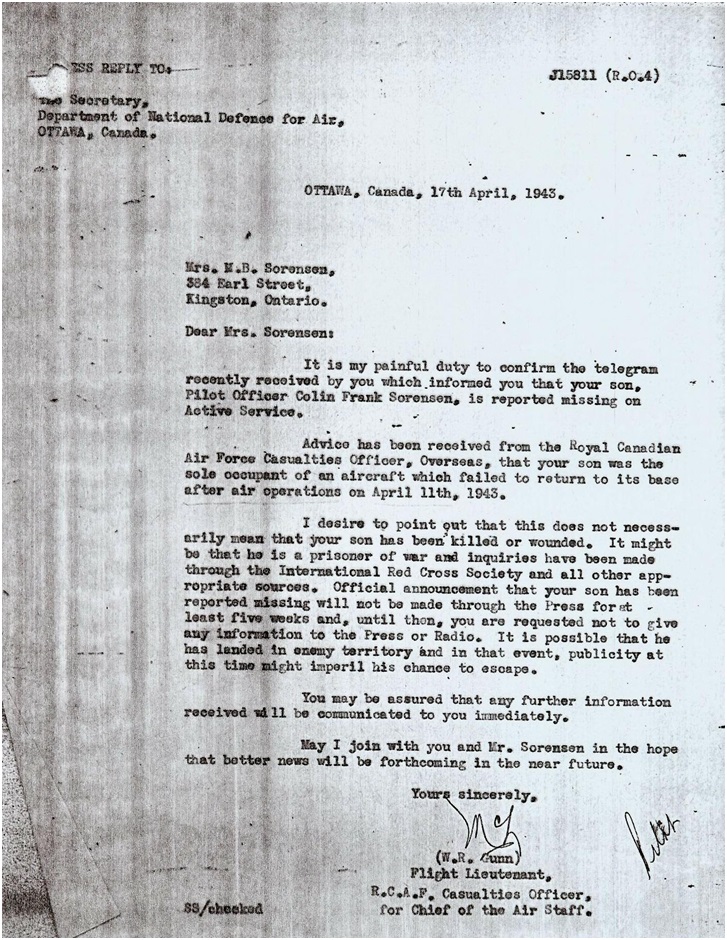
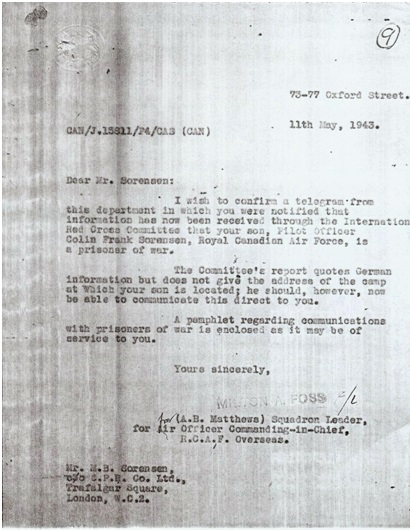
My father was taken to Dulag Luft, Frankfurt and then to Stalag Luft III, Sagan.
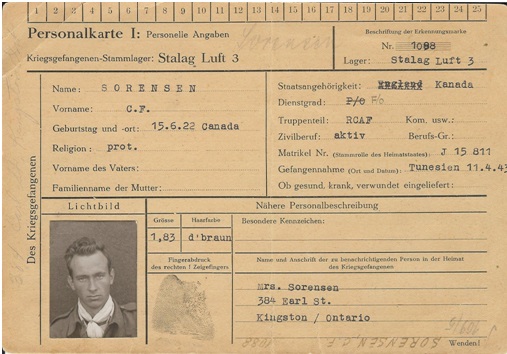
Below are pictures from Stalag Luft III with Robert Buckham, a forger (author of the book Forced March to Freedom, with subsequent documentary released in 2001 by Paperny Films), and Eric Foster (author of Life Hangs By a Silken Thread) who alledgedly feigned “going round the bend” in order to be repatriated:
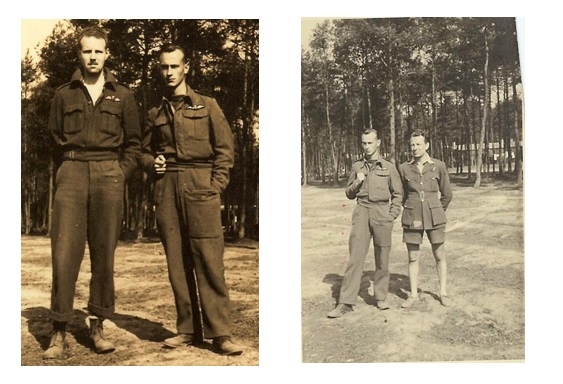
The following is an excerpt from a letter dated June 26, 1943 in which he mentions P/O Buckham:
Had some pictures taken by the Germans here in Camp. Will send one with this letter. The chap beside me is P/O Buckham a Canadian bomber type from Toronto. He is in our room. Being a commercial artist he keeps himself busy from morning to night painting posters and pictures, posters for the various lectures and debates we have on the camp.
The following is an excerpt from a letter dated July 21, 1944 in which he refers to Flt./Lt. Foster:
Eric Foster is on the next repatriation – old Kreigy, you know and slightly round the bend. He said he’d call on you. His wife’s Danish. I tried teaching him Danish but for all he learnt I might as well have taught a horse.
In October 1943, my father had an appendectomy without the benefit of anaesthetic. The huge scar on his lower right abdomen was testimony to the complications he faced after the surgery. I’ll always remember the look of bewildered amusement on his face when he told me a dog was circling the table during his surgery. His appendix was thrown to the floor and the dog ate it.
My father’s role in the tunnel digging was a penguin. He also assisted others to learn Danish and German phrases, with Roger Bushell (Big X) being a recipient of Danish lessons. (My father told me he taught Danish to Roger Bushell while we were watching the movie The Great Escape). My father’s escape plan was to travel by train making his way to Denmark. He once told me his escape number was 81 but apparently he relayed many years ago to my brother’s wife and a close friend that he had an early escape number, 6 or 16, to go out of the tunnel but traded with another escaper. He felt that taking an early express train exposed them to greater scrutiny and risk. The POW he traded with was eager to get home to a wife or fiance and a young child – it may have been a child he had not yet seen. This POW ended up being one of the 50 that were executed and my father never let go of the guilt he felt over that trade. When telling this story, he lamented “that should have been me.” Neither my brother’s wife or my father’s close friend remember who it was.
Jonathan Vance’s book A Gallant Company has Johannes Gouws, as number 6. His role in the escape activities was also a penguin. I have no other information about this POW and whether he was married or had a child. A list given to me by Kathryn Pulman, Arnold Christensen’s great niece that was made by Jonathan Vance has my father’s name penciled in with a question mark beside #74. Her mother who was in contact with Jonathan Vance at the time of his book research cannot remember why.
One could also speculate that my father’s original plan was to either travel with his best friend, Arnold Christensen, a New Zealand Dane, or James Catanach, an Australian. They appear on different lists together as either 9/10 or 15/16. They were captured at Flensburg near the Danish border. Both my father and Arnold Christensen had extended family in Denmark and my father had a family friend in Sweden. Hal Espelid, a Norwegian and Nils Fugelsang, also Norwegian had traded with Dick Bartlett for his spot. They were also caught near Flensburg. James Catanach had a fiance back home in Australia, and as well, an 8-year-old nephew who he was very close to. Arnold Christensen also had a fiance back home in New Zealand, and a young nephew who was born in 1943, after he had been shot down. Either Arnold Christensen or James Catanach could have been the trading partner my father spoke of. All four POWs were executed.
My father’s brother Eric Sorensen was serving in Italy with the Canadian Base Reinforcement Depot, 8 Battalion as an Intelligence Officer when the letter below inquiring about whether my father was among the escaped prisoners who had been killed was sent on his behalf.


In a letter dated June 9, 1944 my Uncle Eric relays the following information to my grandfather in England. My grandparents may have been aware of a Canadian Press newspaper article dated May 19, 1944 headlining “Six Canadian Airmen Among 47 Shot by Huns”:
“I have found out that Frank was not one of the six “killed” through RCAF HQ here in Italy. He may be one of the few that escaped though. I think not however or his letters would not have been so depressive up the 20 March besides they show an interest in future mail from us and what to send him (snaps). I was worried for a while, though. Conception of values never go deeply until you miss them.”
My father spoke little of the long march from Sagan to Lubeck. He was distressed about not being able to take with him, the heavy blanket that he knit out of discarded socks he unravelled. The details of the harsh conditions over the four month trek from January 1945 to May 1945 were not shared with me. My brothers however were told only of how the POWs were freezing and slept in barns, crying and clamouring together, sometimes naked, to try to stay warm. He relayed an incident where he and a friend snuck away at night to get eggs from a farm, to be shot at on their way back over the fence. This person may have been killed because my father said he paid for those eggs with his life. My father never spoke about the “friendly fire incidents” of strafings and bombings by allied air craft or traveling by train in overcrowded cattle cars. On April 19, 1945, RAF Typhoon fighter bombers strafed and bombed a column of POWs near Gresse thinking they were enemy troops. About 30 were killed and 30 injured. This incident coincides with the route and location my father was at during the forced march. I believe he may have been in this group of POWs when he scrambled for cover to get away from the onslaught. When I was a child I thought it would be funny to sneak up on him and scare him. It was a mistake. My father blasted me and told me never to scare him again. He said “imagine having bombs going off all around you and when it finally stopped, realized you had tried to dig a hole in the ground with your bare hands.”
At the end of the march, the group of POWs my father was with was at a farm at Wulmenau, near Trenthorst, south of Lubeck. They were liberated by the 2nd Fife and Forfar Yeomanry supported by the 1st Cheshire Regiment at noon on May 2, 1945. While the tanks were arriving, my father was given a Luger by a German guard as a sign of surrender. My father relayed a story to my aunt about how they had been asked by their liberators how the German guards treated them. My father told them their treatment was reasonable and fair except for “that guy over there – he was a real bastard.” He was taken away and they never saw him again.
One of the things my father carried with him on the long march, was a drawing of the memorial that was constructed for the fifty prisoners of war who were executed by the Gestapo after the escape.
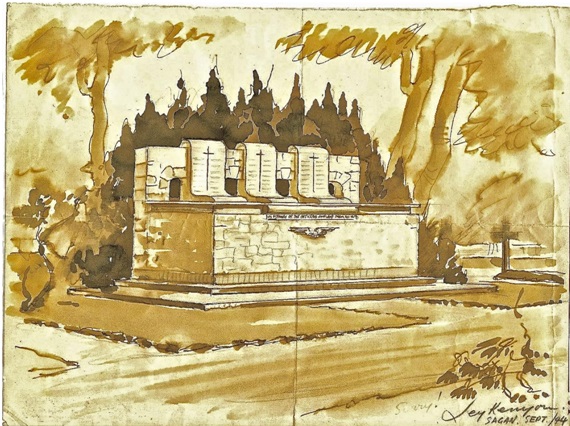
Drawing by Ley Kenyon of the memorial for “Sorry” (Frank’s nickname) September 1944
The following is a letter to my father’s family in Canada dated May 15, 1945 after arriving in England:
My darling Mother & Company;
This is the first letter I’ve written since my return and it’s the first time I’ve used a pen for two years so my writing will not be my very best.
I sent you a cable from Bournemouth the day after I arrived in England. I was flown out from Germany in a Lancaster – a two hour trip – we didn’t see anything from the time we entered the plane till we got out on English soil, and what a reception we got. Waafs met us by the plane and carried our bags to a large hangar where people were serving tea and cakes. Flags and Waafs every where – I hardly ate a thing, I was too busy watching “things”.
Spent three days in Bournemouth getting clean clothes, medical and all kinds of papers, coupons etc. and now I’m enjoying peace and quiet at Dad’s flat here in London reading through all your letters for the last six months. You see I did not receive mail after I left Sagan.
I think I’ll stay here in England for about a month till the great rush at Bournemouth has settled down. I’m also hoping to meet Eric here before returning. I always seemed to miss him – whenever I was in London he was away and when he was in London I was away. I long to get back and see you all again. I might consider IE as my bat woman we’ll see how efficient she is. She has really grown up hasn’t she. I’m warning you two now, when I return I’ll give you the worst bear hug you ever experienced. I hope Dennis will be home when I come and Wif and IE will be home for sure. We’ll have such a lot to talk about so much to do. Tomorrow or the next day I’ll be helping Miss Hall in her garden, it has been left so long and really needs tidying up. Miss Hall is a dear old lady. I love her and you will too when you meet her.
It looks as if I’ll have to wait a while before returning to Denmark. If I hadn’t been so keen to get back to England in a hurry I would have jumped on the tanks that liberated us and gone with them through Denmark. They were some of my happiest moments in my life when I climbed up on the first British tank and had my picture taken by the tank commander together with a whole tank load of yelling and crying Kriegies. It was around noon. We had seen our tanks in the distance earlier in the morning then suddenly everybody started to run (we were at a large farm near Lubeck) then I heard them shout “the tanks, they are here” and I ran also and when I got there all I could see of a tank was a dirty big gun sticking out in front, the rest of the tank was covered with Kriegies. A week later I was in England from the 2nd of May to 9th of May we were in trucks going west.
It’s a lovely day today. I think I’ll go shopping now. We get double ration for about a month after our return so I’ll have more than I want. Be seeing you soon.
Love to all, Frank
Below is a letter my father wrote after his repatriation to Canada, dated July 23, 1945, to his brother Lieutenant Eric Sorensen who was still in Holland interrogating German prisoners:
“Dear Eric;
We are quite a couple of letter writers you and I; it’s almost disgusting the number of stamps we spend on each other, but of course, we have been so terribly busy the last couple of years, so we’ll have to allow for that. In case you haven’t heard about my sightseeing tour through Europe here it is in brief. Having operated in North Africa for about four months with no more excitement than ground strafing enemy transport once in a while, I welcomed the order by my flight commander one Sunday morning at about 7:00 while flying on a wing (3 Squads) sweep 23000 feet over Tunis; to break away and polish off a few Ju. 52s flying low over the Bay of Tunis.
It didn’t seem to have taken any time at all before we, all three of us, our No. 4 had been shot down in flames on the way down and landed in the drink, were skimming the waves, creeping up on our sitting targets. My flight commander got the first one, I flew right past him as the cannons tore in to the fuselage and engines. Next time I looked back it had crashed into the drink in a large ball of fire. It had been heavily laden with troops for I could see them swimming about in the burning petrol. When I had caught up with mine a huge fleet of 52s heading north Italy bound turned back towards land and safety, but I sent two of them crashing in flames into the drink. Bags of fun I thought, until I was reminded by half a dozen Me. 109s that crime does not pay. I wouldn’t have met these 109s if my commander upstairs had not told us to come back up for I had in mind to go home on the deck. I was first attacked at about 3000 feet while crossing the coast on my lonely way home. Out turning three attacks there and using the rest of my ammo with no results, I prepared myself for an exciting flight home. It only last fifteen minutes for after having out turned about a dozen attacks the thirteenth finally hit my engine. Oil covered my windscreen completely. I was in a steep turn at the time all my straps were loose for I like flying with them so, I only tighten them for landing; this I was trying to do as the ground came closer.
I never did get myself strapped in nor did I get time to switch off or turn the petrol off, I knew it was hilly country and not enough height to bail out so I did as I had done before when crashing with Spitfires – I closed my eyes. Well, I hit, I thought and I felt I hit again, I could still think and feel – then I turned a somersault and then with a final crash my flying carrier had come to an abrupt end – upside down. At the moment I thought I was dead and my thinking was just my subconscious mind carrying on. When I had convinced myself that I was not dead I took off my flying helmet and goggles, oxygen mask and loosened my parachute straps I had a look through a hole in the ground, you see I had ploughed right into the ground so my cockpit and myself were completely under the ground. I took one look at the puffing and steaming motor and started digging with my fingers. After five minutes of hard work I heard foot steps and then “hands up.” I had landed right beside a German post. They grabbed me and pulled me out from under the wrecked aircraft. Not until then did I realize how tired I was. I was quite exhausted. Blood was dripping from my head and shoulder where I must have hit, but it soon stopped.
The Germans took me to a tent where they searched me then they drove me to Tunis in an American jeep. There I stayed overnight. An intelligence officer there made a vague attempt to get anything out of me, including the Red Cross forms but we were warned of them. I was alone in a small room, the food was terrible. The next morning I was introduced to an English officer who claimed to have been shot down same day as I. I was suspicious of course, and his name didn’t help matters much, Roder was his name. He told me later that he felt just as suspicious as I, but he was never the less so pleased to see me that he could have hugged me. We just shook hands. While we were in Tunis the Americans bombed it heavily. Lovely sight.
They drove us to an aerodrome the next morning. From there they flew us to Italy same time and same place where we had shot down four German aircraft the previous day. We flew over with twenty to thirty German paratroopers escorted all the way by Me. 109s. I was ready to die a second time after seeing with my own eyes what my own cannons could do to a Ju. 52. However nothing happened. Roder and I stayed locked up in Rome overnight, then continued up through Italy, Munich and Frankfurt, spent the night in the civilian prison – a dirty old cell (breakfast two slices of rye bread and water) then the following morning we were escorted by our paratroop guards to Dulag Luft outside Frankfurt. There I was kept in solitary confinement for five days on poor food. After the second day they discovered I wasn’t talking not even to the extent of being polite so they shoved me back in again and closed the window and from then on I had no more fresh air. They didn’t need any information they might get out of me for afterwards they told me everything about myself – my squad, my friends in the squad – and also quoted a couple of promotions which had taken place less then a week previously. They just wanted me to confirm it, I guess. From there they sent us by rail to Sagan. Arrived there on Hitler’s birthday – every house had a flag out. That was 1943 – in 1945 on our march we didn’t see a single flag out on his birthday.
I’ve already told you about camp life in my letters, I might add that I was also working on that famous tunnel which broke March 24, 1944. As a matter of fact I was among the next five to go down the hole when the tunnel was discovered. I was glad to see my forged papers burning away before the guards came in to the hut. The fellows who were caught were taken to Gorlitz Gestapo centre. Some of them came back to the camp from there, they still don’t know why. They told us how the fifty officers were taken away in small cars in small numbers and never came back. They said there was one fellow with both feet frozen so badly he could hardly walk and still the bastards used the excuse that the fifty were shot trying to get away again after capture. They were simply scared of us; they thought that such a large well organized escape attempt could only be a mass sabotage effort. We had worked on that tunnel for nearly a year.
After this tragedy, which we thought was a great victory at first, future escapes were forbidden by our S.B.O. and most everybody settled down to wait till the end. Then in January the Russians advanced and crossed the Oder at a point due east of us. Everyone was slowly getting prepared for a march – making kit bags, washing socks out, nailing B.C. pack boards together and then in the middle of the coldest winter, 9:00 p.m. while I was listening to a German broadcast by the camp kitchen, Squad Leader Jennens voice rang out “Get ready to leave the camp in an hour’s time.” Everyone was stunned at first then there was a mad dash for the barracks to get packed. Imagine eight men in a little room trying to pack and eat at the same time. Talk about panic. We found we had enough time to knock a sled together from bed ends tying ropes to it so that four could pull while four rested.
I get tired of writing about all that passed misery so I’m quitting. Four out of six weeks leave have already gone. I spent most of my time in the swimming pool and on the tennis courts. Kingston is really beautiful in summer time. I have also tried canoeing for the first time in my life. The second canoe trip I took Mother out and the third time my tennis partner came along. Do you know Cedar Island? Nice place out there!
I regret you didn’t find it worth your gamble to take advantage of that leave I arranged. Even if I only had had seven more days common sense should have told you that I would not have arranged to see you if I didn’t mean to stay until you arrived.
By the way our second march from Westertimke (near Bremen where Himmler was sent to) to Lubeck was quite a vandretur compared with the first one. We crossed the Elbe north of Hamburg. I wish I had stayed on one of the tanks that liberated us and gone up to Denmark with them.
Well Eric don’t let the barbed wires get you down and don’t trust those German girls – they’ll stab you in the back if you have no cigs or when you aren’t looking. You think the German men are fanatics but I know the women are worse.
Love Frank”
The fellow with the frozen feet my father mentioned in his letter may have been Porokuru Patapu (Johnny) Pohe, a Maori from New Zealand.
My father repatriated to Canada the summer of 1945. He met my mother, Betty Bodley on the tennis courts of Queen’s University, Kingston and they were married in December 1946. He attended University of Toronto Dental College and practised dentistry first in Leamington, then in Kingston until he was 65. It wasn’t until after my father’s retirement, when he moved with my mother to British Columbia in 1989, that he became involved with the R.C.A.F. Ex-Prisoners of War Association. A membership directory dated March 1996 holds pages of names and addresses circled by my father.

RCAF Ex-Prisoners of War Association Spring 1994
(Frank Sorensen second row, second from left)
My father’s letter writing in English was very good – this can be attributed to the fact that his mother was British and the family spoke English in their home in Denmark. The Luger pistol that my father received from a surrendering German ended up in Lake Ontario during a canoe outing where my grandmother slipped it over the side into the water. She wanted no relics or reminders of the war or a working gun in her home.

Flight Lieutenant Frank Sorensen 1945

Frank Sorensen, Remembrance Day Service, 2009
A close friend of my father’s told me my Dad once showed him this memorial entitled the Tunnel Martyrs which hung on his wall and said “these were my buddies – they’re all gone.” He remained bitter regarding the violation of the Geneva Convention by the Nazis to execute these prisoners of war.
Note
Next time we turned back the clock to 19 November 1940. Frank Sorensen wrote his first of 174 letters to his parents.
Update
Who shot down Frank Sorensen on April 11, 1943? – Update
If you wish to contact us, please use the comment section or fill out this form.





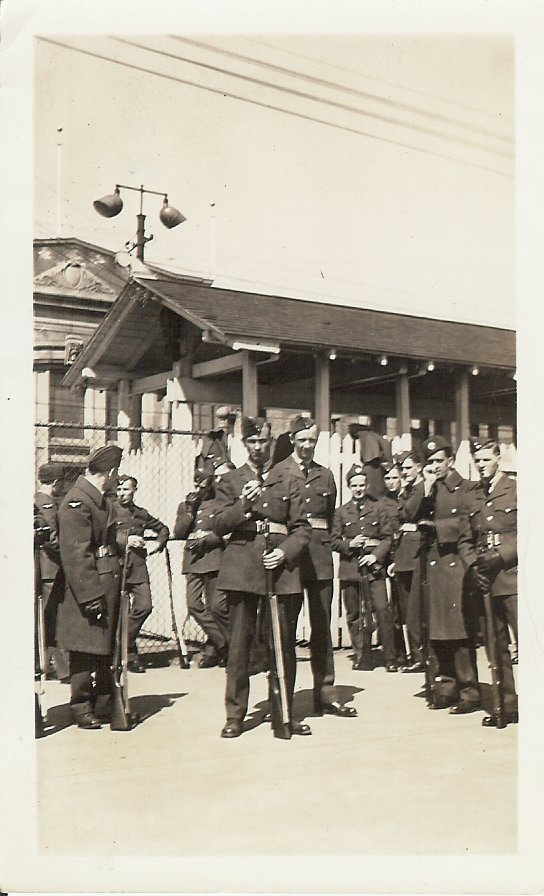
 Frank Sorensen, No. 2 EFTS, 1941, Fort William, Ontario
Frank Sorensen, No. 2 EFTS, 1941, Fort William, Ontario


















